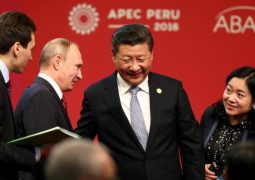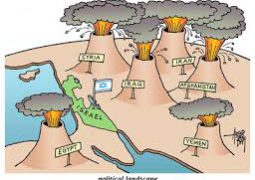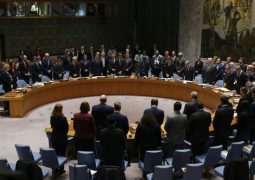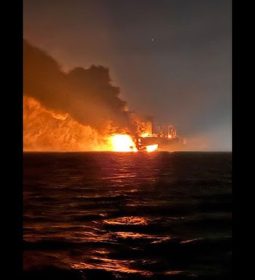Developments in South China Sea: message for Beijing in Vietnam, Malaysia defence white papers

- Defence blueprints by Malaysia and Vietnam went under the radar at first
- But criticisms of Beijing’s actions in the South China Sea are slowly surfacing
Bhavan Jaipragas, Bac Pham
A Chinese destroyer takes part in a joint exercise with Russian navy ships. Photo: AP
The defence white papers published by Southeast Asian neighbours Vietnam
and Malaysia in recent weeks attracted a fraction of the media limelight those of larger countries tend to attract.
That indifference is in part because the two documents – both now in the public domain – held back on detailed procurement plans and spending forecasts and instead offered cautious, heavily nuanced strategic outlooks.
For Malaysia, , the publication of the paper in itself was a major achievement: the country has never publicly released such a document, and did so as part of an initiative by the administration of Prime Minister Mahathir Mohamed to make defence policy more transparent to citizens. Vietnam’s white paper was its first since 2009.
The two documents were released within weeks of each other, but the move was not coordinated by the neighbouring countries.
The main area where both documents have proven insightful is in their assessment of the
regional dispute – in which Vietnam and Malaysia are co-claimants contending with China’s increasingly brazen activities in the resource-rich area.
Beijing claims sovereignty over 90 per cent of the waters, and its so-called nine-dash line demarcating its claims overlaps with the exclusive economic zones of Malaysia, Vietnam, the Philippines, Brunei and Taiwan.
Vietnam’s Minister of National Defence Ngo Xuan Lich welcomes US Secretary of Defence Mark Esper to Hanoi. Photo: EPA
The smaller countries’ chief contention is that China is unilaterally altering the status quo in the waters while talks are ongoing, by constructing artificial islands and positioning government vessels that more than occasionally interrupt innocent passage of civilian vessels.
China says such activities are within its rights because of its interminable sovereignty over the waters since ancient times. Beijing is currently engaged in talks with the 10-nation Association of Southeast Asian Nations to draw up a code of conduct for the waters.
Vietnam in its white paper used particularly strong language to describe the situation in the waters, which it calls the East Sea.
Tensions between Hanoi and Beijing over the dispute heightened this year as a Chinese seismic survey vessel stayed within Vietnamese waters for months, disrupting oil-exploration activities.
The Vietnamese white paper deplored what it called “new developments” in the waters, including “unilateral actions, power-based coercion, violation of international law, militarisation, change in the status quo, and infringement upon Vietnam’s sovereignty, sovereign rights and jurisdiction as provided in international law”.
These activities “undermined the interests of nations concerned and threatened peace, stability, security, safety, and freedom of navigation and overflight in the region”, the document said.
In a commentary this week, Huong Le Thu of the Australian Strategic Policy Institute said the white paper “not only clearly spells out Hanoi’s position, but also endeavours to distinguish Vietnam from those who do not contribute to the preservation of peace”.
South China Sea expert Carl Thayer told This Week in Asia the “sharper commentary” on the sea dispute was “definitely a response” to the three-month Haiyang Dizhi 8.
Thayer said comments by Vietnam’s Deputy Defence Minister Nguyen Chi Vinh at the launch of the white paper on November 26 made it clear Hanoi was sharpening its public stance on the dispute.
Nguyen told local media the country believed in “frankly pointing out differences between us and other countries so as to seek appropriate approaches to settle the issue and protect our national interests”.
“We will uncompromisingly struggle against anything that harms our national independence, sovereignty, territorial integrity and political system,” he said.
While other claimants like the Manila have watered down their rhetoric against China for its activities in the South China Sea, Vietnam for years has stood out for standing its ground.
LESS SCATHING
Malaysia’s white paper offered a less scathing indictment of the state of affairs in the South China Sea.
In spelling out the cause of tensions in the waters, it identified both China and the US military, which has routinely conducted “freedom of navigation operations” (FONOPs) by having navy vessels and air force jets traverse disputed areas claimed by China.
Washington says these actions assert the right under international law for foreign vessels and planes to make innocent passage through the area.
China’s “occupation, militarisation and other activities” in the waters, along with the US Navy’s FONOPs meant the sea dispute had gone from being a matter of regional rivalry to one of “great-power rivalry”, the Malaysian white paper said.
One area in which the analysts said they had hoped for more transparency was in the two countries’ defence spending plans.
In a footnote, the Vietnamese white paper said defence spending amounted to 2.36 per cent of GDP last year. Mohamad Sabu, the Malaysian defence minister, said he hoped his cash-strapped administration – in power since a shock election victory last year – would allocate at least one per cent of GDP to defence annually.
Malaysian Defence Minister Mohamad Sabu, left, with Finance Minister Lim Guan Eng and Home Affairs Minister Muhyiddin Yassin. Photo: EPA
Malaysia’s defence budget of US$3.4 billion for next year pales in contrast to peers in the region that have ramped up spending amid rising strategic uncertainty. Malaysia’s immediate northern neighbour Thaoland less well off in per capita GDP terms, allocated US$7.23 billion for defence this year. In the south, Singapore, Southeast Asia’s biggest defence spender, forecast spending of US$11.4 billion for this year, and is making plans to procure new arms, including state-of-the-art F-35 jets.
While some Malaysian defence watchers lamented that Malaysia was unlikely to come close to spending that kind of money – especially with Mahathir pinching pennies because of the large sovereign-debt headache left over by his predecessor Najib Razak – another concern voiced by commentators was the lack of accountability.
Kua Kia Soong, head of the Malaysian civil society group that blew the whistle on a scandal over the procurement of French Scorpene submarines when Najib was defence minister in the 2000s, said while he was happy that the new government had published its inaugural defence white paper, the “devil is in the details of procurement”.
- Previous Trade Agreement impact? U.S. warship transits Taiwan Strait less than week after election
- Next New ‘shadow commander’ of Iran’s Quds Force EsmaiI Qaani personal friend of late Soleimani
















